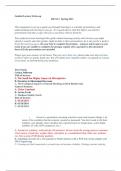Guided Lecture Write-up
BIO 112 Spring 2023
This assignment is set up to guide you through listening to a scientific presentation, and
understanding and learning as you go. It’s a good idea to read this before you attend a
presentation and take a copy with you so you know what to listen for.
Your professors have developed this guide without knowing exactly which lecture you might
attend or exactly what the speaker might include in their presentation. So it may not be a perfect
fit for the event you go to. Do your best to complete the prompts – using as much space as you
need; if you are unable to complete the prompt, explain why a question in this document
doesn’t fit the presentation you attended.
Please type your answers in the boxes. They are set to blue text; please make sure they are blue,
so this is easier to grade, thank you. You will submit your response online, via upload on Canvas
or by email, as determined by your professor.
Your Name:
Ceniya Jefferson
Title of lecture:
A. The Small but Mighty Impact of Miscoplastics
B. Parasites in Mississippi Raccoons
C. The Ecological Impacts of Marsh Ditching on Bird Biodiversity
Name of lecturer:
A. Claire Copeland
B. Javian Ervin
C. Madison Maddy North
Date of lecture:
A. 03/26/2024
B. 03/26/2024
C. 03/26/2024
• Science is quantitative meaning scientists count and measure things. List
some of the variables that the scientist counted or measured. You don’t need to list their
numbers, just identify what variables they reported (such as temperature, water depth,
numbers of cells, DNA sequences, etc.)
A. Amount of synthetic, sold particles off polymers, & how much the average person consumes.
Used variety of particles, weight, fibers, and glitter as a standardized disk, flake size, medium
cut. Also a prop of MP density gradient.
B. Sampling raccoons for a rare parasite in North America with a PCR test, tissue samples and
DNA Sequencing.
C. Clearing out land connected to a marsh area to become a habitat. It brings current velocity,
, water depth, degrees of Celsius, & temperature. Used birds, testing tubes, eyesight, charting,
technology & land.
• Describe some of the data presented. Did the scientist present values of
variables as tables of numbers? Graphs? Diagrams showing a sequence of events?
A. Yes, used both values and variables in charts, bar graphs, Turkey test, and anova. The data
was significant, the 1st test with test 2. There was no difference so the means were averaged. The
Tukey test , the difference was in all but N4.
B. Yes, Bar graphs, comparisons against other countries, and habitat.
C.Yes, Bar graphs, comparisons charting, vinn diagrams and biodiversity index.
A hypothesis is a testable statement about the interaction between two variables. Sometimes it is
formed as a question. For example, “The dose of medication affects how rapidly the symptoms
disappear.” or maybe “Does the dose of a drug affect the amount of pain reported by the
patient?” A hypothesis can be tested by performing an experiment, but many hypotheses are
testable by observations only.
(Note that an experiment is when a scientist chooses or manipulates the value of one or more
variables, such as the dose of a drug, the nutrients in a diet, or the density of seeds planted).
• Did the scientist report the results of experimental tests of hypotheses?
A. Yes
B. Yes
C. Yes
• If your answer was YES, what hypothesis did the scientist test?
A. The average person consumes a credit card size of plastics.
B. If using a PCR test and DNA sequencing, could detect zoonotic parasites harbored by
Mississippi Raccoons?
C. Would the biodiversity be higher or lower in a ditched area?
• What variable did the scientist manipulate? This is called an independent
variable.
A. Spiked testing tubes with micro plastics to contaminate.




